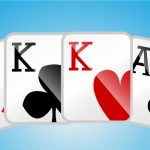Poker is easy to play, difficult to win at, and downright tricky to turn a profit at. For those players looking to go from amateur to profitable, it is hard to know where to start. Well, that’s just what this list is for! Below are the top six best poker training books you will find on the market. Most players do not take the time to read or study other’s methods. Those who do, and especially those who read quality books like the ones listed below, are the ones who turn profits.
5. Hold’Em Poker for Advanced Players, Slansky, Malmuth
The opening line in this book’s summary is: “Texas Hold ’em is not an easy game to play well.” Well, that’s true! Originally published in 1988, this book changed the poker scene forever. It’s teachings and instructions are likely known by many players today who have never read the book, simply because of how far this book penetrated the scene. In 1999, Slansky and Malmuth revisited the book and updated it for today’s game. You don’t want to miss it.
4. Championship No Limit & Pot Limit Hold ‘Em, Cloutier, McEvoy
T.J. Cloutier, one of the early road gamblers similar to Doyle Brunson, has cashed at the WSOP 55 times. Not surprisingly, you’ll find his name in the Poker Hall of Fame; he was inducted in 2006. In this book, he joins up with Tom McEvoy (four WSOP bracelets) to write about tournaments, and how to become a champion. Cloutier, it is worth noting, has won more recorded poker tournaments than anyone else in history. His advice is verifiably excellent.
3. Caro’s Book of Poker Tells, Caro
In the world of poker books, this will likely be one of the first you come across. In this classic (classic, because though it was published in 1984, it is still just as relevant), Caro reveals a laundry list of tells which have made him wealthy for decades. These tells will make you enough money in one session to buy a cart of these books. True, these tells won’t work against the 5% of elite poker professionals, but you might be amazed by how many of these tells are applicable to seemingly unreadable opponents.
2. Doyle Brunson’s Super System, Brunson
Does this book need an introduction? Doyle Brunson is a legend, still living, and his book has something to do with it. Brunson’s playing style in his early road traveling days was downright mythical: nobody understood it, everyone wanted at it, while Brunson built himself stacks of bills. In 1979, Brunson did something which he is still criticized for (but he’s okay with it): in Super System, Brunson gave away his secrets of play, why he plays the way he does, and the many tips and tricks that has earned him a fortune many times over for the better part of a century. You haven’t studied poker unless you’ve read Super System.
1. The Theory of Poker and No Limit Hold ‘Em: Theory and Practice, Slansky
These two books, which could easily be combined into one big book, are not for beginners. In fact, they’re not even intermediate: these are written for the serious, committed player who looks to improve his game every chance he gets. The Theory of Poker focuses on limit poker, but all of its lessons are applicable to NLH as well (you’ll just have to adjust your math accordingly). But instead of adjusting calculations, go ahead and get No Limit Hold ‘Em: Theory and Practice. The two of these poker books combined have been, for at least this author, the difference between barely scraping a profit to pulling in a livable income. These books lay an unshakable foundation, which produces winning results at all but the very toughest of games. These aren’t light reads, but every page you digest is money in your wallet.
Submit your review | |










